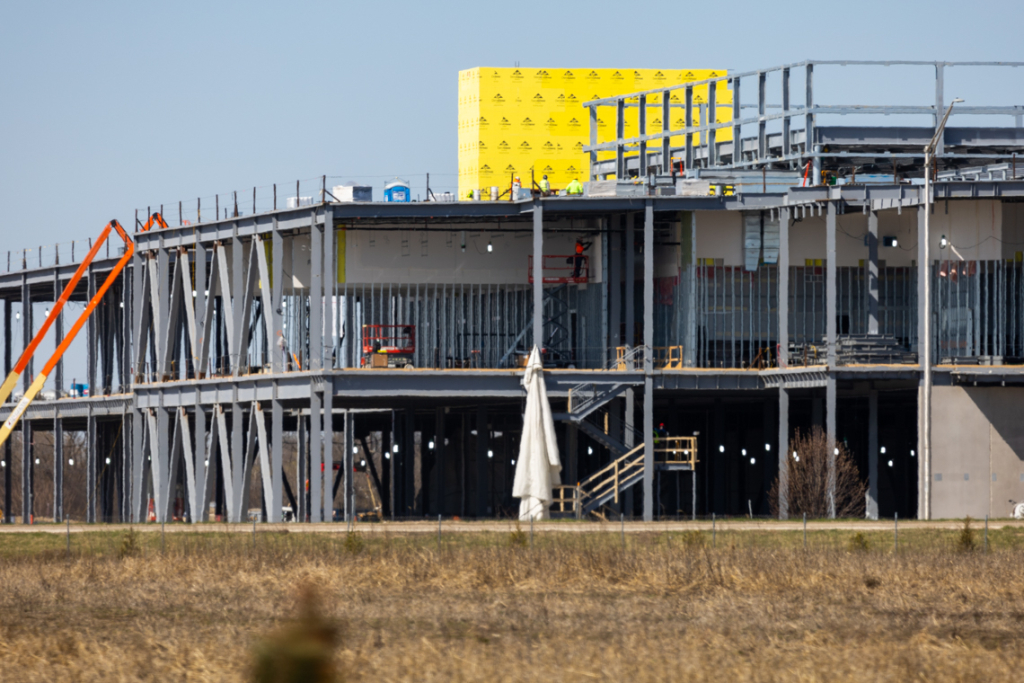
By LEONARDO PINI
Medill Illinois News Bureau
[email protected]
SPRINGFIELD — Illinois has been at the forefront of the data center boom, but state lawmakers are working to gauge and mitigate the impact these centers have on climate and energy consumption.
In the last two decades, data centers have multiplied due to increased demand for cloud computing, information storage and data processing. However, data centers now also serve AI and cryptocurrency mining, which puts new digital coins into circulation and enters transactions on the blockchain.
Powering these data centers is costly, consuming large amounts of water and energy. The growth of this business has prompted concerns about the impact on the environment and the electricity grid, including rising costs for rate-paying consumers.
State Sen. Steve Stadelman, D-Rockford, chair of the Senate Committee on Energy and Public Utilities, has filed legislation that aims to gather data on the industry to determine the impact on energy and water usage and prevent them from putting too much strain on Illinois’ power grids.
“As data centers continue to multiply, they are putting an incredible strain on the grid,” he said. “And this legislation is trying to ensure that residents are not bearing the rise of this energy cost caused by the booming of this industry.”
Under Stadelman’s Senate Bill 2181, companies that operate data centers in Illinois would need to report their annual water and energy consumption to the Illinois Power Agency beginning next spring under threat of $10,000 fines for non-compliance. The IPA would then synthesize the data into annual reports to answer the question of whether residential ratepayers in Illinois are, in effect, subsidizing data centers, along with the environmental impacts of the industry.
Across the U.S., utilities and grid operators are worried by the increased demand of electricity needed for data centers, and some have proposed delaying the closure of fossil fuel plants to support that demand, setting back environmental goals.
A January study by Frontier Group, a coalition of environmental and consumer groups, found at least 17 units at seven fossil fuel plants have seen their planned closures delayed — or are at risk of being delayed — due in part to increased demand from data centers. Most of it is happening in Virginia, where “Data Center Alley” is located, and nearby Maryland and West Virginia.
Stadelman cited similar environmental concerns about Illinois’ goals under the 2021 Climate and Equitable Jobs Act (CEJA), which requires the state to shift to 100% clean energy by 2050. He worries that indiscriminate expansion of data centers could hamper Illinois’ ability to meet that deadline.
“When we passed CEJA, no one anticipated the impact of data centers,” Stadelman said. “That is going to have an impact on our ability to meet our energy demands with these data centers.”
The proposal also calls for the agency to suggest legislative solutions “to mitigate any negative impacts of data centers on rate-paying customers.”
But SB 2181 has not yet received a hearing — or any co-sponsors — despite agreement from fellow state Sen. Laura Ellman, D-Naperville, that data centers’ resource usage could become a problem for Illinois.
“Illinois has a wealth of power and water, but we have to be good stewards of that wealth,” said Ellman, who chairs the Senate Environment and Conservation committee. “One fear I have is that this increased demand from data centers will delay the closure of fossil fuel plants, much like they did in Virginia and Maryland.”
Trying to regulate the business, though, could be “somewhat tricky,” according to Laurance Lewis, senior advisor at Metro Edge Development Partners, a Chicago commercial real estate firm focused on data center development.
All data centers are not the same, Lewis pointed out. There are both “hyperscalers” and “colocation” centers. Hyperscaler data centers are usually owned and operated by one company, such as tech giants like Google or Amazon. Colocation centers, on the other hand, rent out space to smaller companies, which could make it difficult to collect data on resource usage.
“If you are a data center landlord of a retail colocation facility, you have multiple tenants. Some of their energy and water consumption may not be metered precisely” Lewis said, noting that poorly crafted legislation could be “unduly burdensome.”
An October study published by the Center for Secure Water at the University of Illinois found that hyperscalers can use up to 550,000 gallons of water per day, while smaller data centers can consume up to 18,000 gallons per day.
However, Lewis argued that many critiques on water consumption are “overblown,” claiming the data center industry is “self-regulating” and trying to find solutions, “such as a closed-loop water system that does not require millions of gallons of water.”
Recently, the need for such large expenditures of resources by U.S. data centers has been called into question with the emergence of new Chinese AI large language model “Deepseek,” which reportedly consumes less water and power than Open AI and other competitors.
Cushman and Wakefield, a global real estate services firm with a Chicago office, assesses that Chicago’s metro area currently hosts 1.2 gigawatts of operational capacity, with 169 megawatts under construction and about 2.6 gigawatts already planned in upcoming years.
Nevertheless, a comprehensive study to estimate data centers’ impact on the electricity grid is difficult to find. The rapid boom of data centers in recent years means their impact is still up for interpretation.
In the meantime, data centers are multiplying. The Chicago Tribune reported last month that a new data center in Minooka, 40 miles southwest of Chicago, could be opened by California-based Equinix Inc. by 2034. The new structure, the Tribune reported, will need 3 million gallons of water per day and 700 megawatts of power.
Weighing the economic benefits
As in many other municipalities, local leaders and residents are weighing the economic benefits of the project — including new jobs and tax revenue — against possible environmental tradeoffs. But absent state action like the data collection called for in Stadelman’s bill, those environmental factors are currently difficult to quantify.
Andrew Chien, director and founder of the Center for Unstoppable Computing at the University of Chicago, believes that in the meantime, “planning is always important.”
“In Virginia, for example, they are building fossil fuel generators alongside renewables because they did not have an adequate plan to support the demand of power data centers required through renewable energy,” said Chien, a professor at the University.
But he pointed out that Illinois has a different mix of energy sources than Virginia, owing to the state’s 11 reactors at six nuclear plants — the most of any state — “and ample wind and solar resources.”
“I think the right way to deal with this is to build capacity with those clean energy resources to be prepared for the growth in data centers,” Chien said. “If we are prepared, we would not only attract jobs and investments. We would also do so in a way that does not increase carbon emissions.”
On this note, Lewis agrees with Chien: Illinois is different from other states, as Illinois’ energy market deregulated nearly 30 years ago, opening it up “to the entire country to procure energy,” he said.
“Going back to fossil fuels is less likely to happen in Illinois than in a regulated state,” Lewis said. “There are solar projects in DeKalb, for example, some wind projects and new technology coming in the market like hydrogen fuel cells and Dairy Renewable Natural Gas. There is a general sense that fossil fuel can only take us so far.”
While the coexistence of technological innovation amid the shift towards renewable energy has proved problematic in other parts of the country, Illinois legislators think it is still early enough to tackle this issue.
Rep. Carol Ammons, D-Urbana, chair of the House Energy and Environment committee, said it’s “critical” for state policy to “achieve this balance” allowing those two sectors cohabitate.
“I think it is a false choice to put our environment and innovation against each other, it should not have to conflict.” she said. “We need to protect our environment and ensure that up-and-coming technology develops sustainably. We need to regulate the industry to ensure technology does not pollute our communities while allowing new fields to emerge and provide opportunities.”
But environmental concerns are not the only possible pitfall for data centers. Another concern is their impact on energy customers, who could see the cost of their rates spike in upcoming years. Sarah Moskowitz, executive director of the Chicago-based consumer advocacy group Citizens Utility Board, said she worries that Illinois’ energy capacity may be monopolized by data centers in the near future.
“In Illinois, we have put together solutions to ensure adequate energy supply for citizens through ratepayer support for nuclear power plants,” Moskowitz said, referring to fees approved by the General Assembly in the last decade that support the continued operations of nuclear plants in the northern half of the state as a bridge to expanding more renewable energy.
“Those supports do not expire for a couple of years, but now is the time to start working on strategies to ensure that the power generation that citizens need is not all gobbled up by these single, powerful customers.”
Moskowitz warned that the growth of data centers could cause higher prices for energy for consumers and cautioned that “the entities that control the information about data centers are the entities that benefit the most from inflating demand projections.”
“Suppose those data companies can outbid everyday ratepayers for electricity generation,” she said. “In that case, that is removed from the overall markets and exacerbates real or perceived energy supply shortages that drive up market prices.”
Leonardo Pini is a graduate student in journalism with Northwestern University’s Medill School of Journalism, Media, Integrated Marketing Communications, and a fellow in its Medill Illinois News Bureau working in partnership with Capitol News Illinois.Capitol News Illinois is a nonprofit, nonpartisan news service that distributes state government coverage to hundreds of news outlets statewide. It is funded primarily by the Illinois Press Foundation and the Robert R. McCormick Foundation.






